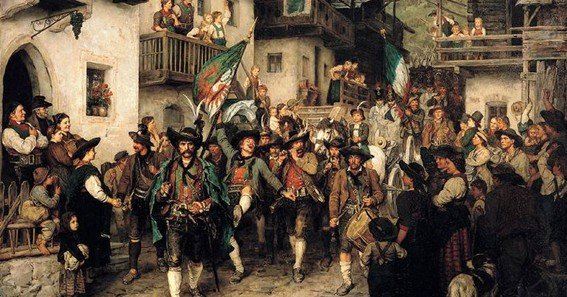In 1809, amidst the turmoil of the Napoleonic Wars, the concept of the “Landsturm” emerged as a pivotal element in local defense strategies across various European regions. The term “Landsturm” refers to a militia composed of local inhabitants, primarily tasked with defending their homeland against invading forces. This grassroots military organization played a crucial role in uprisings such as the Tyrolean Rebellion, showcasing the determination of local populations to resist foreign domination.
Formation and Purpose of the Landsturm
The Landsturm was established as an auxiliary force to support regular armies, especially during times when professional military resources were stretched thin. In regions like Austria-Hungary, the Landsturm comprised men typically aged between 34 and 55, who were called upon to defend their local territories. These units were responsible for maintaining order, protecting communication lines, guarding fortresses, and performing other essential military services within their regions. Their formation was a response to the pressing need for localized defense mechanisms during widespread conflicts.
The Landsturm in the Tyrolean Rebellion of 1809
One of the most notable instances of the Landsturm’s involvement occurred during the Tyrolean Rebellion against Bavarian and French occupation. The Tyrolean Landsturm, composed of local militia fighters, played a significant role in the series of battles known as the Battles of Bergisel. These engagements, particularly the second battle on May 29, 1809, saw approximately 13,600 Tyrolean irregulars, alongside 1,200 Austrian regulars, confronting Bavarian forces. Despite being less formally trained and equipped, the Tyrolean Landsturm utilized their intimate knowledge of the mountainous terrain to effectively challenge the occupying forces, exemplifying the impact of local militias in resistance movements.
Legacy and Impact
The mobilization of the Landsturm in 1809 underscored the vital role of civilian militias in national defense during the Napoleonic Wars. Their contributions not only provided immediate tactical advantages in various skirmishes and battles but also fostered a sense of unity and resilience among local populations. The experiences of the Landsturm highlighted the effectiveness of irregular warfare tactics and the importance of local knowledge in military engagements. Moreover, their involvement set a precedent for future defense strategies that integrated civilian forces into broader military planning.
FAQ
1. What was the Landsturm in 1809?
The Landsturm in 1809 referred to local militia units formed to defend their homelands during the Napoleonic Wars, particularly in regions like Austria-Hungary and Tyrol.
2. What roles did the Landsturm fulfill?
The Landsturm was responsible for maintaining internal order, defending communication lines, guarding fortresses, and supporting regular military forces in local defense.
3. How did the Landsturm contribute to the Tyrolean Rebellion?
In the Tyrolean Rebellion of 1809, the Landsturm played a crucial role by utilizing their knowledge of local terrain to effectively resist Bavarian and French occupying forces.
4. What was the typical age range of Landsturm members?
In regions like Austria-Hungary, the Landsturm typically comprised men aged between 34 and 55 years old.
5. What legacy did the Landsturm leave for future military strategies?
The Landsturm’s effective use of irregular warfare and local knowledge influenced future defense strategies, highlighting the importance of integrating civilian militias into national defense plans.










